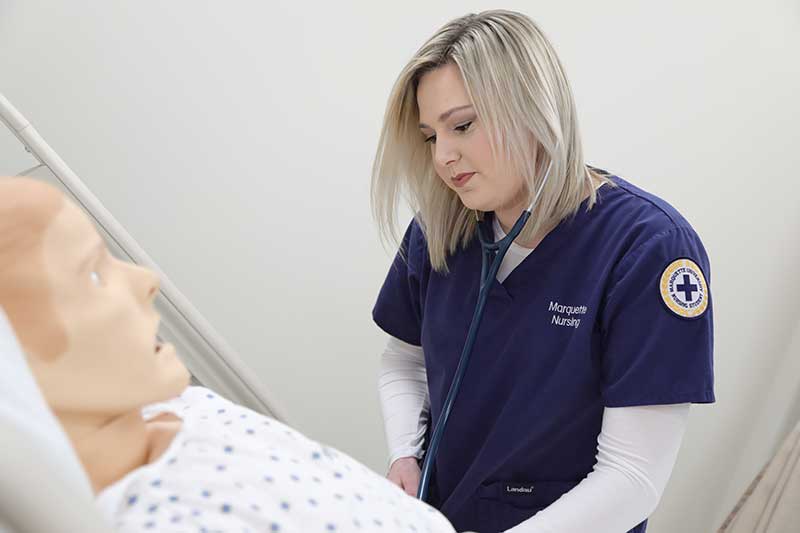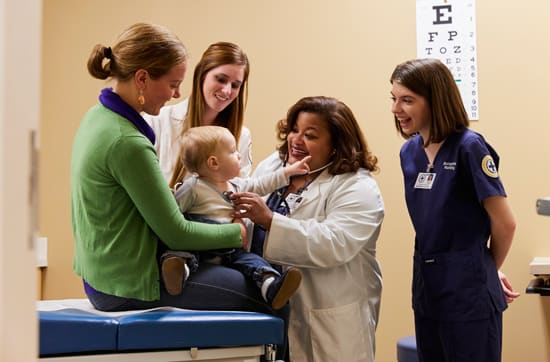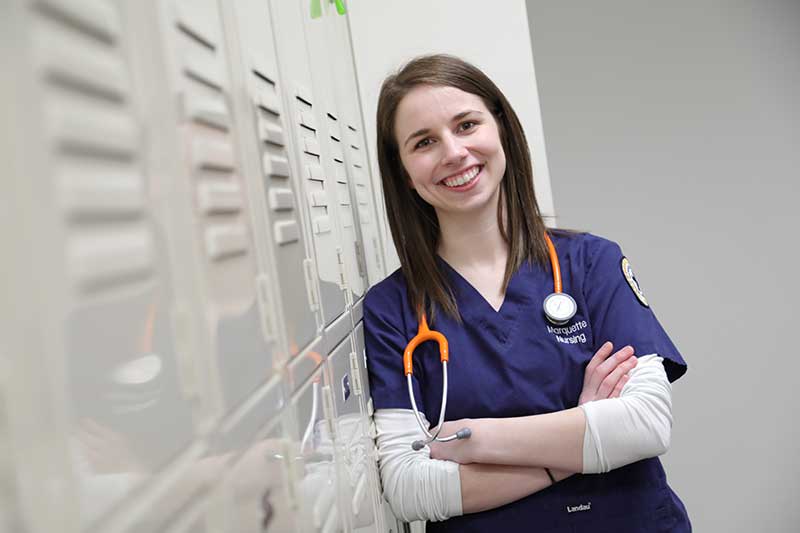How to Become a Nurse Practitioner: 5 Steps
Each blog post is dated and contains accurate information as of that date. Certain information may have changed since the blog post publication date. If you would like to confirm the current accuracy of blog information, please visit our Direct Entry MSN overview page or contact admissions at (866) 891-8438.

With many experienced nurses deciding later in their careers that they want to become nurse practitioners, it makes sense for prospective nursing students to think about pursuing an MSN from the start of their nursing education. You may ask, “What are the benefits of earning a master’s degree in nursing?” You might also be curious about how to become a nurse practitioner with a non-nursing bachelor’s degree.
Marquette University’s Direct Entry Master of Science in Nursing (MSN) program makes it possible to transform your non-nursing bachelor’s degree into an MSN. The Direct Entry MSN is an invaluable route to earn your degree and enter a new career as a nursing leader in as few as 19-21 months.
First we’ll discuss why it makes sense to become a nurse practitioner, and then we’ll explain the process of how to become a nurse practitioner in five steps.
Why Become a Nurse Practitioner?
There are many reasons to become a nurse practitioner (NP). NPs can provide care that differs from registered nurses. They can bridge the gap between RNs and primary care physicians while serving populations in need of quality care. Like the nursing profession in general, the demand for nurse practitioners exceeds the supply. In fact, the role of the profession is growing so rapidly that U.S. World News & Report recently named nurse practitioner as #1 in its list of best healthcare jobs and #2 in its overall list of the best 100 jobs for 2022.
Among the many nurse practitioner benefits are opportunities for career specialization and growth.
Some of the specialties within advanced practice nursing (APRN) that you can pursue as a nurse practitioner include:
- Acute Care
- Adult Health
- Family Health
- Gerontology Health
- Neonatal Health
- Oncology
- Pediatric (Child and Adolescent) Health
- Psychiatric/Mental Health
The scope of services nurse practitioners can provide still varies from state to state. However, as the demand for healthcare services increases, the number of states that allow nurse practitioners a full scope of practice is increasing. The number of nurse practitioners nationwide is growing quickly; at present, there are more than 325,000, according to the American Association of Nurse Practitioners.
5 Steps to Become a Nurse Practitioner
For those who are interested in becoming a nurse practitioner but do not currently have a nursing degree, the answer to the question, “How do I become a nurse practitioner?” can seem complex. However, with a non-nursing bachelor’s degree, you can still access an elite nursing education and become a nurse practitioner on an accelerated timeline. Let’s examine the steps you will need to take before entering this new career field.

1: Earn an MSN Degree
For non-nursing bachelor’s degree-holders, the first step toward becoming a nurse practitioner is to get a master’s degree in nursing. You could first earn your Bachelor of Science in Nursing (BSN) degree and then an MSN degree, but there is a more direct route available.
Enter Marquette University’s Direct Entry MSN program. Offered at Pleasant Prairie and Milwaukee, Wisconsin, our accredited program lets you leverage your previous, non-nursing bachelor’s degree to earn an MSN in 19-21 months.
Because you already have a bachelor’s degree, you likely have many of the non-nursing liberal arts credits required for a nursing degree. You may need to take a few additional courses to fulfill the prerequisite requirements. Typically students with Bachelor of Arts degrees need to take a few science courses, such as anatomy. Then once in the program, you will focus exclusively on nursing theory coursework. This singular focus on nursing is what allows us to provide a comprehensive masters’-level nursing education in under two years.
During this time, you’ll:
- Complete didactic coursework, either online or in-person, designed to accommodate multiple learning styles.
- Engage with professors, clinical experts and peers while participating in active learning activities, discussions, assessments and exams.
- Gain hands-on experience in our high-fidelity simulation center.
- Put what you’ve learned into practice via clinical rotations at some of the area’s top healthcare facilities.
2: Obtain Your Nursing License
Upon graduation from our Direct Entry MSN program, the next step is to sit for the National Council Licensure Examination (NCLEX-RN®). This step is crucial, as you must pass the NCLEX to receive nursing licensure. To help students prepare for the NCLEX, we administer practice exams each semester.
One of the great things about applying for a nursing license in the state of Wisconsin is that the state belongs to the Enhanced Nurse Licensure Compact (eNLC). This means that nurses can apply for a multistate license, allowing them to practice in more than 30 states without the need to apply for a new license.
3: Gain Experience in the Field
This step likely comes as no surprise, but it’s an important one. Prior to beginning clinical rotations in a post-master’s certificate program, you need at least one year’s worth of professional nursing experience. The reasoning is simple: Before pursuing an advanced nursing position, you need to understand what it’s like to work as a nurse in the field. Besides, while you may leave our program with an MSN degree, you’re going to learn a lot in that first year of working — both about nursing and about working with other healthcare professionals.

4: Obtain a Nurse Practitioner Certificate
Once you have a year of experience, you can put your skills and knowledge to work and pursue certification as an advanced practice nurse (APRN). At Marquette University, we offer a number of certificate options, including:
- Acute care nurse practitioner (ACNP) (adult or pediatric)
- Primary care nurse practitioner (NP) (adult or pediatric)
- Health systems leader
Typically, post-master’s certificate programs and the time it takes to earn a certificate will vary from school to school. In addition, during the program you will work with patients during clinicals under the direction of nurse practitioner preceptors.
5: Secure Your APRN Licensure
After completing your post-master’s certificate specialty program, you will sit for your APRN licensure exam. After obtaining licensure, nurse practitioners will work with individual state boards of nursing to complete the necessary steps to practice and prescriptive authority.
It’s worth noting that while many states participate in licensure compacts, these do not apply to being a nurse practitioner. To learn more about your state’s APRN licensure requirements, visit NursingLicensure.org.
Leverage Your Non-Nursing Bachelor’s Degree to Earn an MSN in 19-21 Months

Ready to make the jump to a career in nursing? With three program starts each year, our accredited second-degree MSN program lets you start working toward becoming a registered nurse sooner. To find out if Marquette University’s Direct Entry MSN program is right for you, give us a call, or fill out the form to have an admissions advisor reach out to you.
